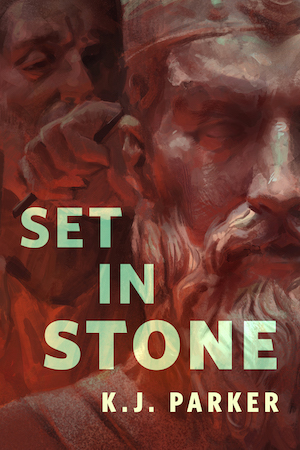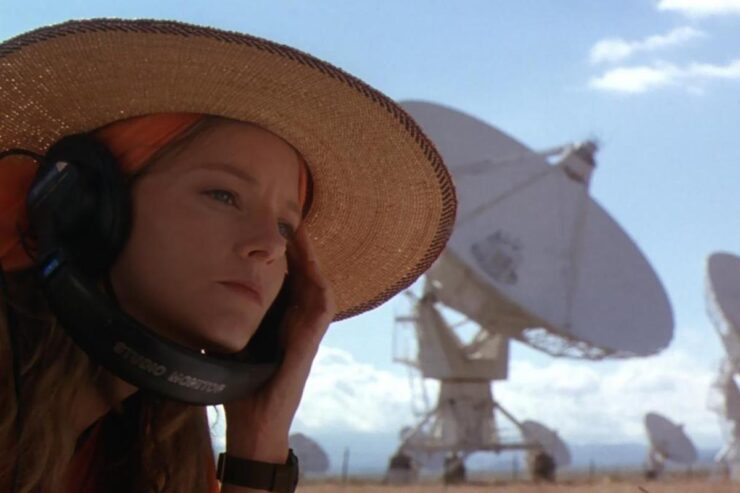Contact (1997) Directed by Robert Zemeckis. Written by James V. Hart and Michael Goldenberg, based on the novel by Carl Sagan and the story by Carl Sagan and Ann Druyan. Starring Jodie Foster, Matthew McConaughey, Tom Skerritt, and James Woods.
In October of 1980, American PBS stations began airing Cosmos: A Personal Voyage, a science documentary in which astronomer Carl Sagan takes viewers on a wide-ranging tour across time and space. For several years afterward, Cosmos was the most-watched television show in the history of American public television. It was subsequently broadcast in countries around the world and remains one of the most popular science documentaries ever made.
Universal appeal was, in fact, the goal of Cosmos, as well as Sagan’s reason for accepting when he was asked to co-write and narrate the series. Cosmos was not the first series to target a wide general audience with educational approaches to scientific topics; the BBC show Horizon and the PBS show Nova were both well-established by 1980.
But Cosmos hit differently. It was made with a high budget, a globe-trotting production, state-of-the-art special effects, and enchanting music by Vangelis (who just two years later would compose the soundtrack for Blade Runner). It launched Sagan to international fame as a science superstar. More than that, it provided a contrast to the weary, cynical science skepticism that had been so popular since the end of World War II. As a 1980 Time profile on Sagan puts it, in the previous years, “Science, or more accurately its offshoot technology, was being blamed for much that was wrong with the world: the growing despoliation of the environment, the chemical devastation of the Vietnamese countryside, the spread of nuclear weaponry.” People were ready to feel awe and enthusiasm again, and Cosmos did exactly that.
While Cosmos was in production, Sagan began working with his co-writer Ann Druyan on another project. With the support of producer Lynda Obst (who would later produce Interstellar in 2014), they put together a pitch for a fiction movie about a realistic take on humanity’s first contact with an alien civilization.
The film went into production at Warner Bros., but the project stalled for several years. Sagan and Druyan’s treatment went through numerous rewrites, some of which sound utterly terrible. Apparently Peter Guber, Obst’s boss, was obsessed with the idea of Dr. Ellie Arroway being a mother and having motherhood be the emotional core of the story. Obst, Sagan, and Druyan were all eye-rollingly displeased with that idea. As Obst said in a 2022 retrospective in Variety, “I think the biggest mistake that the people made was that they didn’t understand that it was possible for a woman to want to give her life to knowledge instead of to a husband and child.”
(Hey, sci fi writers: raise your hand if you’ve ever been told that a female character should be a mother to give her character more meaning… *raises hand* Yeah, it still happens.)
During that time of Hollywood limbo, Sagan went ahead and wrote the idea as a novel. He also married Ann Druyan; they remained married until his death in 1997. Sagan’s novel Contact was published in 1985, and it would take the better part of a decade, plus some odd twists and turns, for the movie to climb out of development hell. According to Obst, Warner Bros. took Guber off the film and asked Obst to help get it back on track. Even then, the film went through two directors before the third one stuck; the first two were Roland Joffé, who quit, and George Miller, who was fired for, essentially, taking too long. I just want everybody to take a moment to imagine what George Miller’s Contact might have looked like. This would have been George Miller post-The Witches of Eastwick but pre-Babe. That movie exists in some alternate universe. The mind boggles.
In this universe, however, Contact did end up in the hands of Robert Zemeckis, the wildly successful director of Romancing the Stone (1984), the Back to the Future trilogy (1985-1990), and Who Framed Roger Rabbit (1988), which is one of the best movies of all time (I will fight anybody who disagrees). Perhaps more relevant, however, is that Zemeckis had just finished directing Forrest Gump (1994), making him the obvious choice for another big, earnest movie about important things happening to impressive Americans.
I’m being a bit glib, but in fact I was surprised by how much I liked Contact this time around. I first watched it when I was in college, a year or two after its release, and I thought it was all right but didn’t have much reaction beyond that. When I sat down to watch last week, I remembered all the key plot points and characters, and I assumed my response would be the same as it had been before.
But time changes us, and we never really watch the same movie twice. I went in expecting to be mildly interested as I noticed things to write about. My reaction, however, was more similar to Roger Ebert’s 2011 return to the film, in which he updated his initial review and wrote, “Watching the film again after 14 years, I was startled by how bold it is.” Bold is an interesting word to describe a mainstream film from ’90s Hollywood, but I think Ebert was on to something.
The film follows Dr. Ellie Arroway (Jodie Foster), a radio astronomer who has dedicated her career to searching for signs of extraterrestrial life. This makes her something of a pariah in the scientific community, as many fellow scientists think there are better uses for both brains and resources. I don’t know enough about the scientific search for extraterrestrial intelligence to know how realistic that is, although I do know enough about being a woman in the physical sciences to do a full-body shudder every single time a man speaks over her to claim and explain her research.
I also know enough about doing scientific research (although it has been a long time) to notice the quaintly dramatized elements of the plot. I find these moments more silly than egregious or troubling, to be honest, because I also know how storytelling works. It’s natural for a film to skip over the dull bits, like writing grants and spending months poring over squiggly graphs of data. Films, unlike real-world science and politics, can ignore fiddly, bureaucratic details in order to be interesting; Contact personifies nearly all of that in the character of David Drumlin (Tom Skerritt). When a story deals with very big and broad themes, it makes sense to have individual characters and specific events represent complex, opposing ideas, even if that means leaving a great deal of nuance by the wayside.
When Arroway identifies an extraterrestrial signal from outer space, it immediately blows up into an international sensation. Everybody wants to play a part, from scientists to governments to religious leaders to ordinary people who just want to be part of the experience. Among the major players are Palmer Joss (Matthew McConaughey), a Christian philosopher and activist, Michael Kitz (James Woods), head of the U.S. National Security Council, and billionaire S.R. Hadden (John Hurt), who along with Arroway and Drumlin form the lynchpins of the story’s themes.
A lot of critical writing about Contact, both contemporary and in retrospect, discuss it as a film about the tension between science and religion. But that’s an incomplete picture: it’s a film about the tensions between science, religion, and politics.
Those three cultural axes are naturally simplified for the film, but they are simplified in ways that make sense for telling this story in this medium. Arroway relies on data and evidence, but more than that, she believes that scientific curiosity and discovery are important for their own sake, separate from any obvious benefit or material gain. Joss occupies a rather ill-defined space as a sort of public religious figure whose primary concern is in ensuring that science and technology help rather than harm humanity. Arroway and Joss have multiple discussions about belief and faith and the existence of a deity, but their disagreements are largely amicable, even flirtatious, until the difference between their beliefs become a matter of global politics.
Kitz represents political interests and concerns in a very particularly militaristic way. His character brings to mind the saying that if the only tool you have is a hammer, everything looks like a nail, only his tool is the defense and national security machine of the United States, and that makes everything look like a threat. (We need not dwell on the matter of that character being played by noted right-wing-conspiracy-peddling nutjob James Woods.) Drumlin, for his part, seems to play all of those angles with relative success, although it still ends very badly for him. And characters like Hadden and the religious terrorist Joseph (Jake Busey, looking like a long-lost Targaryen cousin) represent different extremes. Hadden’s character has aged pretty poorly; the ’90s conception of an eccentric fictional billionaire being secretly helpful has been replaced by the depressing reality of pathetic man-child billionaires throwing public tantrums. But Joseph’s character feels even more relevant today, as anybody with even a passing knowledge of American politics is well aware that destructive, doomsday-craving quasi-Christian extremism is alive and well.
There are a lot of characters in Contact, but Arroway is the only one we get to know in any depth, in terms of learning about her past, her family, her beliefs, her motivations. We see many years of her life, from her childhood tragedy all the way through her professional struggles and the complicated consequences of her scientific triumph. Jodie Foster is great (of course) at showing both Arroway’s prickliness and her passion. The rest of the characters are thinner, but I think it’s partly by design. I think we are very much supposed to look at many of the main players as stand-ins for broader swaths of humanity. This approach is not completely successful—it’s a whole lot of white American dudes arguing in rooms, so there is a hard limit to how “universal” any of them can be—but I do think it’s a deliberate storytelling choice.
Related to that choice is the film’s emphasis on media coverage of the discovery and subsequent events. We’ve seen this technique before, such as in The Day the Earth Stood Still (1951), Godzilla (1954), and Close Encounters of the Third Kind (1977). But it’s more pronounced here, because Contact comes from the era of 24-hour cable news and nonstop punditry; it builds realism for its audience by using numerous snippets of media reports, talk shows, interviews, and speeches from public figures. Real people are all over the film: Larry King, Jay Leno, Geraldine Ferraro, and several CNN reporters.
President Bill Clinton also makes a couple of appearances in clips from real speeches that were digitally altered to make it appear as if he was talking about aliens. The first of those scenes, when the president announces the alien signal, is an edited version of President Clinton’s announcement about the famous Martian meteorite ALH84001. The second clip, the one where the president says, “Let us deal with this on the facts,” was taken from a 1994 press conference about Saddam Hussein. The White House was not happy with Contact for using these clips in this manner; they sent a strongly worded letter right after the film opened. There were no legal proceedings or consequences, but the discussion at the time did touch on a lot of issues around a person’s ownership of their own image and how the images of famous people might be used.
(Aside: There was a whole ugly legal mess around Contact after the film’s release, but it was about something else. Francis Ford Coppola, in an ill-disguised attempt to legally strongarm Warner Bros. on another matter, filed a lawsuit against the studio and the Sagan estate claiming that he had developed the idea for Contact with Sagan in 1975. Druyan recalls receiving notification of the lawsuit on the day of Sagan’s funeral. The lawsuit and subsequent appeal were ultimately dismissed.)
Contact is focused on a character at the very center of the story, one who has more information about the events than the general public. So the news reports aren’t there for the characters to learn vital information, as they are in Close Encounters of the Third Kind, but for the audience, to help create an experience that is expansive rather than intimate. The film supplements our perspective on Arroway’s personal experience with direct reference to our own experiences of being captivated observers of world-changing events. It’s a curious approach, reminiscent of what Zemeckis did in Forrest Gump by weaving the story into real historical events. It also has an old-fashioned feel to it—a callback to that certain type of story that is most interested in exploring the wide-ranging implications of a big science fictional idea.
When Sagan and Druyan first conceived of the idea for Contact, their goal was to construct a realistic fictional scenario about humanity’s first contact with alien intelligence. The film doesn’t really demand that we relate personally to its characters, even while we find ourselves sympathetic to or critical of their points of view. Instead, it is inviting us to participate in the story as everybody else. The rest of humanity on Earth, the people in the crowd, the ones who aren’t a direct part of the big events and can’t affect their outcome, but are watching it all play out on television without knowing where it will end.
Along the way, Contact asks a lot of questions about how humankind goes about its business of living in the world: What is the purpose of science? What responsibilities do we have to be sure our technological progress helps rather than harms? What are the limits of knowledge and faith? How do we make choices that affect the whole world when the world can’t agree on anything?
The film certainly has a perspective on most of these topics; it isn’t shy, for example, about emphasizing the difference between faith as a personal experience and religion as a political tool. The fact that the story was conceived in part by a scientist, science communicator, and lifelong advocate for science education is always apparent, even through the filter of Hollywood’s necessary dramatics.
Carl Sagan died before the film was finished. He worked on it right up until his death, but he never got to see it. So he never had the chance to say what he thought about it, nor about how the movie’s ending differs from the book’s—the bit about the 18 hours of recorded static is an addition that implies less ambiguity about Arroway’s experience. I think that addition was the right choice for the movie, as it provides us with a satisfying little ah! moment, the sort of conclusion that implies forward momentum rather than a big question mark.
As I was watching, I kept thinking about one aspect of the story that’s somewhat rare in science fiction cinema, although it’s more common in sci fi books and television. Sci fi movies in particular tend to be rather skeptical of science and technology, and cynical about what humanity will inevitably do with the things we invent and discover. That wariness is present in Contact, but it’s not the driving force behind the story. The premise is not built on the assumption that humanity can’t handle future discoveries or advancements, even one so astonishing as first contact with an alien civilization.
Contact is unusual for a sci fi movie in that it genuinely loves science, and it seems to like humanity pretty well too. Because, sure, fear and distrust and paranoia and greed are all part of humanity—but so too are boundless curiosity, a hunger for knowledge, and a tremendous capacity for wonder and awe. Maybe we can handle it, even if we do make terrible mistakes, even if there are big, scary, strange things out there for us to discover and experience. Maybe we’ll be fine.
What do you think of Contact? I haven’t read the book, but I’m sure some of you have. What do you think of the differences? And would you get into the machine, even knowing there was a chance you might never come back?
Next week: Let’s head into… someplace, to look for… something… somehow. It’s time for Andrei Tarkovsky’s Stalker. Watch it on Max, Criterion, Amazon, or Apple.










